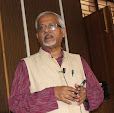
Humanism is an integral part of Indian belief system. Gods and goddesses do behave like normal human beings. Festivals like Durga Puja symbolise our urge to relive our faith in these culture specific oral traditions.
CJ: Arindam Roy, 16 Oct 2007 Views: 967 Comments: 0
DURGA, THE dear daughter of the Himalayas, comes to her parents’ home every autumn. She arrives with her children, Lakshmi, Kartik, Saraswati and Ganesha. She stays at her parents’ abode, the Martya-loka (earth), for four odd days. This has been the belief amongst the Bengalis for ages.
It’s difficult to trace how and when this belief (read mythological story) gained popularity. But Durga, who is both the mother for her devotees and the daughter of the Himalayas, is believed to be a reincarnation of Sati. She had died of grief and shame when her father, King Daksha, insulted her husband, Shiva, ages ago.
Allow me to digress a bit. When Shiva came to know of it, he let loose his matted hair and danced in terrible rage. With the body of Sati on his shoulder, Natraja was inconsolable. Even the gods shuddered. Pralaya (deluge) was certain. Vishnu came to their rescue.
Vishnu spliced the various parts of Sati with his Sudarshan Chakra. Wherever the various body parts fell, the places became sanctified as ‘Teerthas’. Later, each of these places came to be known as Shakti peethas. Shiva was told that Sati would come back to him in later births as Uma.
Durga is a manifestation of Uma. It’s immaterial if another story, during the wee hours of Mahalaya (October 10, this year), had told the story of the birth of Durga in a different shade. The Hindu Trinity (Brahma, Vishnu and Maheshwara) had opened their ‘Trinayana’ (third eyes) at the same time. A powerful fire-like glow, red in colour was ablaze. From it emerged the warrior-goddess, Durga.
She was named Durga, which meant the one difficult to approach. In another sense, as Durgatanashini, she puts an end to all ‘durgatis’ (grief). While different layers of stories might confuse the mind, the believer is quite at ease with all these so-called contradictions. There is a saying in Bengali, “Bishas melay mon, torko kore onek dur” (faith bridges minds, debate creates distances).
The faith of faiths is a touchy matter. But, let’s find out why strange stories about gods gained currency. Have you ever wondered why gods behave like human beings?
Why Durga comes to visit her parents’ home annually or why Shiva enjoys his marijuana? Why Bal Krishna stole butter? Similarly, why Jagganath of Puri, who bathes once a year shivers and has fever? Once every 12 years he is cremated with his siblings in his private crematorium, and so on.
Amitabh Bhattacharya, a senior journalist in Varanasi, explained that humanism – the belief that gods behave like human beings – gained currency in the post-Pauranic era. In fact, the period between Puranas and 10th century AD, the time of Muslim invasion, saw a spurt of miracle-performing gods. This was also the time when angry gods became a part of the Hindu pantheon.
He explained that Buddhism, Jainism and Islam had threatened the very matrix of Hinduism. Those amongst the ordinary masses, who could not be won over with devotion (bhakti), had to be scared in some ways. The Hindi poet of the Bhakti movement, Goswami Tuslidas had said, “Bhai bin preet nahi” (No love without fear), is an example.
“But, why fear? What role has fear in religion? Even the Holy Bible categorizes different kinds of fear. It talks of good fears and bad fears. The fear of god is a good fear,” stated Sebastian John.
Fear of being cursed by angry gods stopped large-scale conversions. The fear of burning in hell, causing grave curse to the forefathers and future generations, might certainly be seen as a good marketing ploy but it helped the Hindu sages and seers to keep the flock together.
Durga, Chamunda and Kali – the terrible forms of Shakti – had the elements of fear inbuilt in them. To mellow the fear element, the motherhood aspect, the all-forgiving, all-loving goddesses were also weaved in these stories. At a more mundane level, it was said, “Don’t our mothers get angry? But, do they love us any less?” reasoned Mausumi, a schoolteacher.
At another level, the Aryans accepted the Dravidian-tribal gods. An authority on iconography, B Mukherjee explains in his book that one way to distinguish between gods of Aryan and non-Aryan origin is that the former always have water cosmology. Thus, Brahma, Vishnu, Lakshmi, Saraswati, et al are of Aryan origin, while Shiva, Durga and Kali belong to the non-Aryan roots.
Never mind if a god of Aryan origin is the child of a god of non-Aryan origin. In this case, all children of Durga are Aryans, while she herself is of a non-Aryan origin.
But why ask so many questions? Just enjoy as the drums roll (Dhakis) and the heady fragrance of Dhunichi fills the air.
(Link: http://www.merinews.com/catFull.jsp?articleID=127038 )












No comments:
Post a Comment